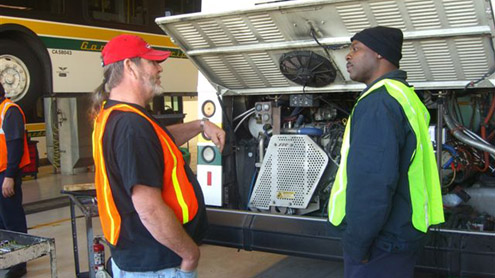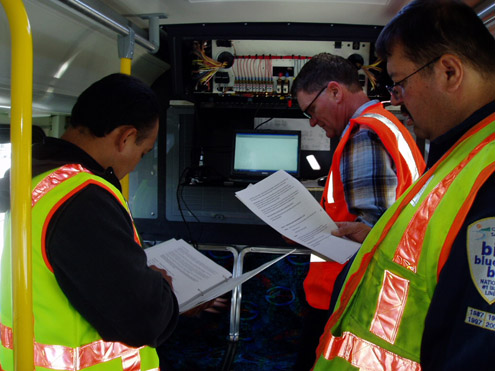

The new learning model from Southern California transit consortium meets evolving needs and raises the bar
By Nina Babiarz
Challenged with regional air emission mandates put forth by the South Coast Air Quality Management District (AQMD) to operate and maintain low-emission transit buses, Southern California transit agencies could no longer just talk about the need to develop and deliver updated technician training.
Since transit authorities are often the first to deploy many transportation technologies “en mass,” the Southern California Regional Transit Training Consortium (SCRTTC) formed to find and share solutions to the problems of evolving technologies looming large over the transit industry and outpacing their preparedness to address these advancements.
The work begins
SCRTTC first established its Transit Training Needs Assessment to identify and anticipate industry skills training needs for now and in the future. This academic assessment complemented with practical experience of the transit industry, ultimately melded a much needed hands-on component of transit training into classroom instruction.
Working with a very small pot of funding, this incorporated group of 43 members consisting of municipal transit authorities, community college members, affiliate members and private industry partners took the initiative nearly 10 years ago to lead the development of a national transit training model. The consortium now enjoys national recognition for its transit training accomplishments.

Assessments & goals surveyed
The SCRTTC has been persistent in achieving its goals:
-Develop a new learning model to increase the professional and technical competency of the Southern California public transit workforce
-Assure this learning model includes the elements of Intelligent Transportation Systems (ITS)
-Develop industry driven, competency-based courses that meet present and future needs
-Expand the model to regional and national levels
The initial Transit Training Needs Assessment process was comprised of a detailed regional industry survey with the primary method of data collection being surveys distributed to depict the region followed by a face-to-face workshop.
Using a survey distributed to Southern California bus transit authorities representing a fairly large geographic area, followed by face-to-face workshops, the objective was to identify transit agencies implementing or anticipating the deployment of Intelligent Transportation System (ITS) products and services that may require trained ITS professionals to ensure successful implementation.
Moreover, the survey portion also intended to uncover information that SCRTTC policymakers could use to make accurate decisions in regards to ITS training needs, as well as serving as a guideline in procurement processes. This approach verified and ensured the transit training SCRTTC identified was specifically what was needed as opposed to allowing assumption to drive the assessment.
As the proverbial ITS umbrella covers innumerable technologies, systems and integrated applications, SCRTTC kept the survey questions focused only on the major ITS topics. However, diverse examples as a part of each question enabled a full range of responses that revealed multiple areas of transit training needs.
The highlights of the findings of the ITS surveys focused on what systems and/or equipment were being used, experiencing failures, having key reliability issues, requiring workplace skills needed by new employees or additional maintenance/repair training by existing technicians, as well as those that were expending the majority of the employee’s time.
The value of collaborative observation
Additionally, a two-hour Needs Assessment Workshop was conducted with representatives in attendance from both the transit maintenance organizations and the regional community colleges. The previously referenced survey results were summarized and presented to the attendees in order to stimulate discussion of what training and skill needs transit agencies required in order to maintain current and anticipated ITS systems and equipment. A variety of training topics and observations were discussed such as:
-Employee computer skills critical to trouble shooting
-Better diagnostics make trouble shooting easier but still include basic electrical and electronic skills
-Diagnostics require knowledge and optimum use of diagnostic tools e.g. PCs, laptops, multi-meters
-ITS equipment subcomponents and assemblies are frequently treated as disposable items which eliminate the troubleshooting process
-Agencies see substantial rapid changes in transit technologies over the life of a bus
-Technicians need to have a better hand in specific essential skills as they address and resolve common technical issues, maintenance activities and failure modes.
-ITS overview targeted to technicians beneficial to understanding how/where their work fits into the overall system
This list consisted of common tangible and practical skills necessary for technicians to successfully diagnose, repair, and maintain transit bus ITS systems. Ironically, the essential skills listing read somewhat like a job posting.

Tapping existing resources
The next task was to review all existing and available training programs and determine if these existing resources could meet the newly established training criteria. This review identified an inventory of academic subjects and a host of career certificates from community colleges in Los Angeles, Orange, San Bernardino, Riverside and San Diego counties. It also revealed a number of instruction programs for skills that assessment deemed necessary and in some cases severely lacking in the transit industry. Also, because California has the largest community college system in the nation, accessibility to these courses and their instructors by each transit property makes them extremely valuable assets in the equation of solving this transit training problem.
The final step was to take the training inventory and compare it to the transit training needs as assessed. Identifying gaps in the most needed training areas helped the SCRTTC to prioritize the order and delivery of the different types training in an appropriate and attainable timeframe.
The initial assessment results were summarized in a report entitled the Transit Agency ITS Survey and Transit Agency Maintenance Manager and Trainer ITS Surveys and set down the foundation for funding in 2007 which enabled the SCRTTC to undertake a more detailed and updated assessment which became the keystone component to the SCRTTC’s implementation of a solid training development and delivery track record.
By analyzing the gaps in skills, this method assisted in the development of future programs that targeted the most effective delivery mechanisms of those programs by which the gaps would be addressed and the transit systems benefit. This endeavor also helped to further enhance the choices, increase the options, reduce replication, and increase availability and accessibility of the transit training programs throughout the Southern Californian region.
The objective of the 2007 assessment was to expand the training topics and current training needs beyond the identification of only ITS products and/or services and encompass all transit training topics that are relevant to the transit industry training requirements.
This inventory of training topics, conducted independently with the SCRTTC transit and community college members, revealed the current transit training courses that were available and being conducted by the member entities and those still needed by transit agencies.
SCRTTC identified the following list of common tangible, yet essential, skills as necessary to aid or improve technician abilities to successfully and effectively work with, diagnose, repair and maintain transit specific ITS systems and equipment. They are:
-Basic electrical and electronics theory and practical applications
-Personal computer usage and basic computer programming
-Troubleshooting skills
-Use of diagnostic tools, especially multi-meters and PCs
-Specific vendor supplied or vendor system-specific training
-Knowledge of Computerized Engine Controls
-Read system schematics i.e. wiring diagram
-Locate and interpret technical manuals and specifications
The group also identified specific instructional aides and other educational resources and made them available in order to bring the training to fruition by the SCRTTC members. Over the years these instructional aides have revealed such priceless gems as transit brake assemblies, CNG cutaway tanks, HVAC simulators and stand alone test engines, just to name a few.
The SCRTTC’s successful learning mode has its foundation in the Needs Assessment and Skill Gap Analysis methodology described here. Further details can be found on the SCRTTC website on the ‘New/Publications’ tab in the ‘Publications and Presentation’ section at: http://www.scrttc.com/news.htm BRM
Nina Babiarz serves as training director for the Southern California Regional Transit Training Consortium (SCRTTC), La Mesa, CA.
